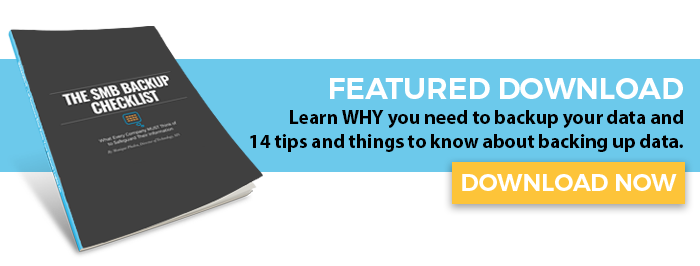Disaster Recovery – Stats, ROI, and Your Business' Exposure
August 16th, 2017 | 3 min. read

Disaster recovery often seems like a remote possibility for businesses relative to the day-to-day work of keeping the business running.
Partly I think that's because many SMBs think “disaster” and they think flood, fire, tornado, hurricane, etc. They then look around and think, “My odds are pretty good for missing most of those issues, I'm good.”
However, when you define “disaster” as anything that causes disruption to your business, those odds change dramatically.
Laptops and PCs get old and crash. Networks can be penetrated. Your users could fall for a phishing attack and expose your business to ransomware.
In fact, human errors remain the top cause of downtime.
Let's take a look at recent research about disaster recovery and consider what the numbers mean for your business.
One number immediately stands out: 6%.
That's the number who report never having experienced downtime. The majority – 71% – experienced downtime in the past 12 months.
And the cost of downtime? While larger enterprises estimated that a day of downtime would cost over $1 million; 36% of companies of all sizes estimate downtime costs to be between $10K - $100K per day.
Given that a year of data backup/disaster recovery can cost less than a day of downtime, the ROI is obvious. ROI doesn't include peace of mind knowing that your business can recover should a disaster strike.
Only 20% of companies currently use a disaster recovery solution that provides continuous data protection, which means that 80% of companies are at high risk of data loss.
This is true, as far as it goes. However, not every business and every type of information needs continuous data protection. Depending on the volume of data and systems, this type of protection can be pricey. That said, from some businesses, continuous data protection absolutely makes sense. In other cases, it doesn't. Consult with your IT department and/or managed IT services partner to determine how frequently your data and systems should be backed up for disaster recovery.
Only 13% of companies managed to do a monthly disaster recovery drill and 31% conduct drills a few times a year. Surprisingly, 10% of companies admit that they never conduct disaster recovery drills.
These drills can be hard for the IT departments for SMBs. They take time and mean that some other tasks may fall behind. As a consequence, they don't do it very often. In reality, that means that the data backup you thought was saving your data for a rainy day might not actually be working. Managed IT companies have the staff and resources to conduct drills.
Two other stats I found interesting:
-
More than 50% of all companies surveyed use a public cloud for their disaster recovery target site, while only 17% use physical machines and 27% use private clouds.
-
Over 60% of the enterprises surveyed and 44% of all the companies surveyed use disaster recovery for half of their production machines.
Companies are including more of their equipment in disaster recovery efforts. That's good. The use of the public cloud also shows a steady rise in acceptance that public clouds ARE secure enough for the most business critical needs.
 All stats from the 2017 Disaster Recovery Survey Report: Disaster Recovery Challenges and Best Practices sponsored by CloudEndure
All stats from the 2017 Disaster Recovery Survey Report: Disaster Recovery Challenges and Best Practices sponsored by CloudEndure
Mo is the resident IT go-to lady at AIS. She has traveled the world, run a marathon, is a self-proclaimed crossword champion, and can do ventriloquism. She has an uncanny memory ....down to the detail. She has completed 4 half marathons and hates running. In her free time, she likes to spend time with her 7 siblings and 20 nieces and nephews.
Topics:


